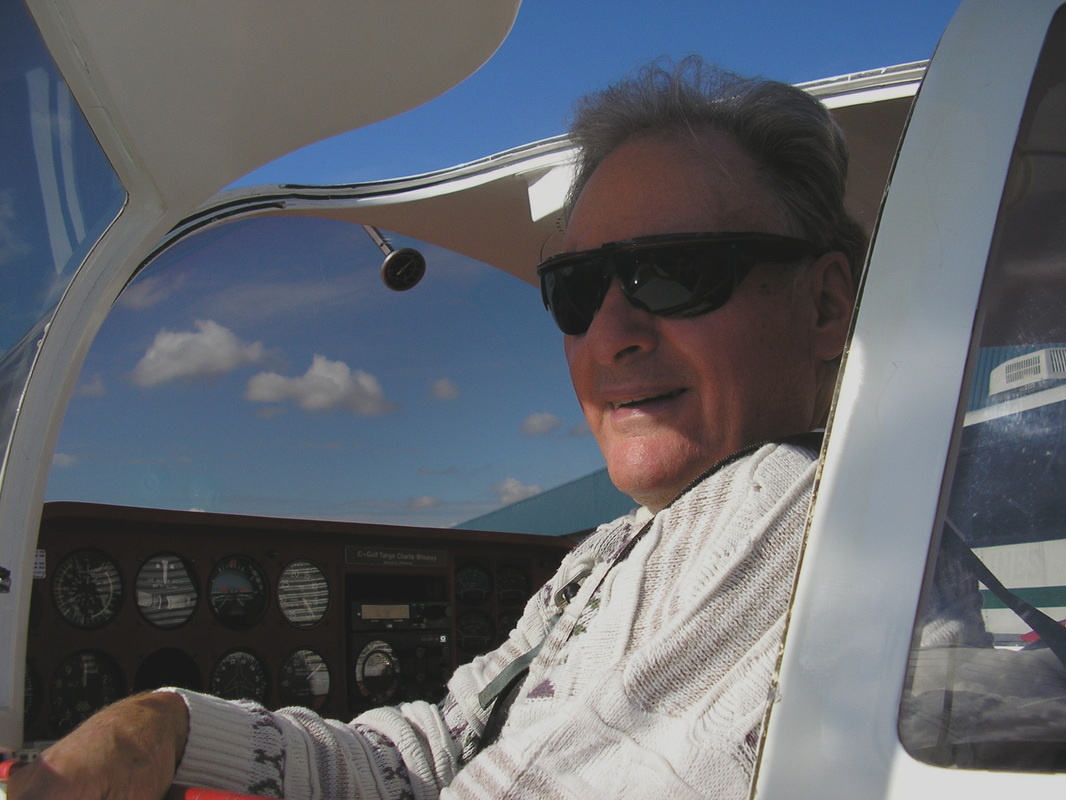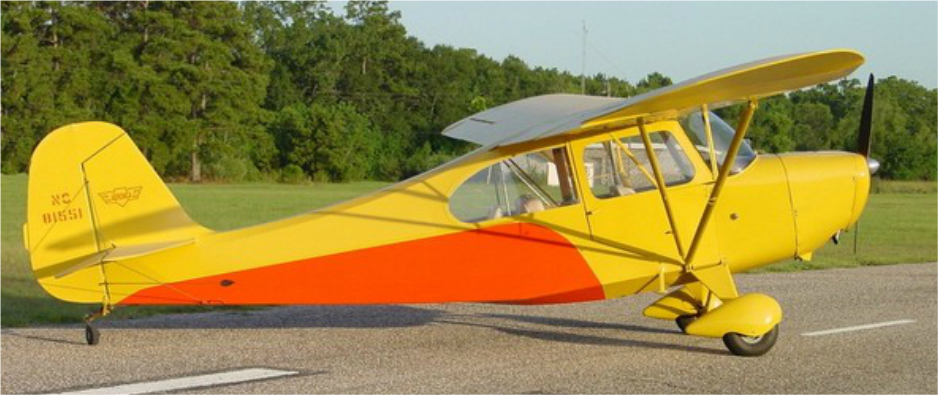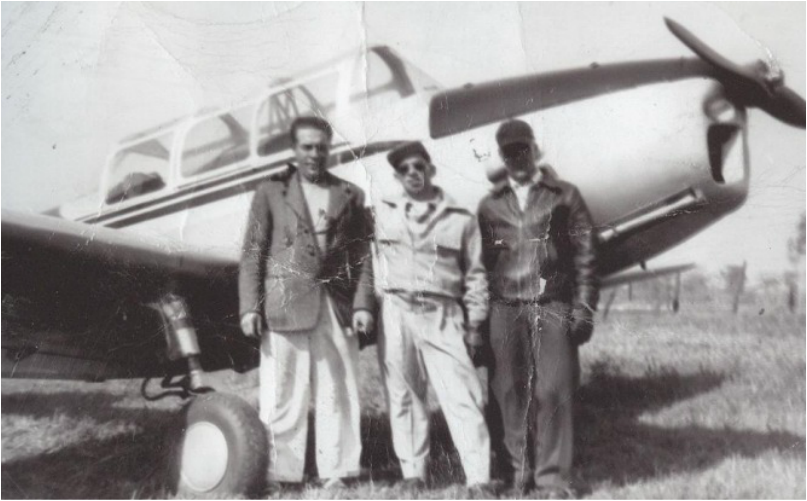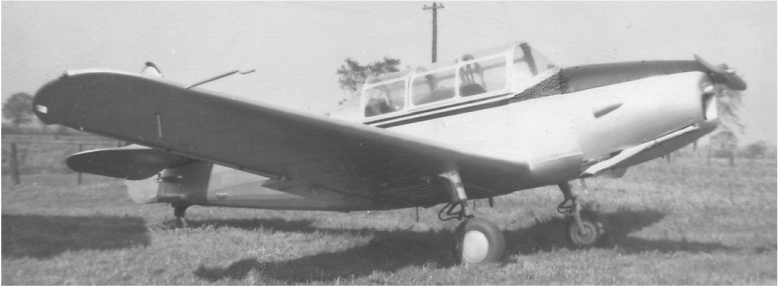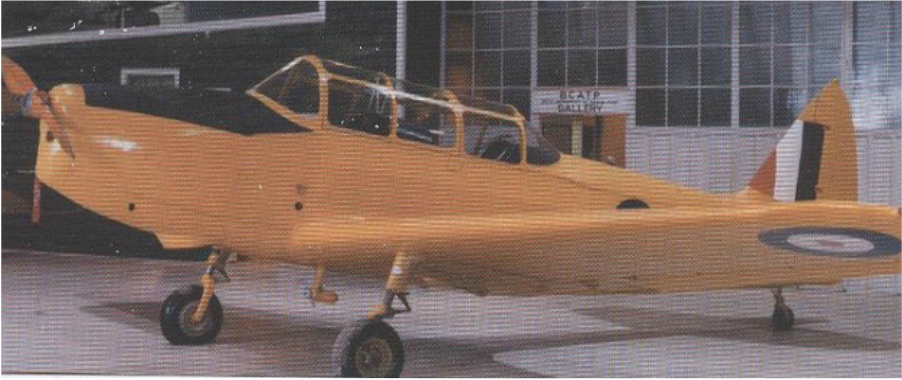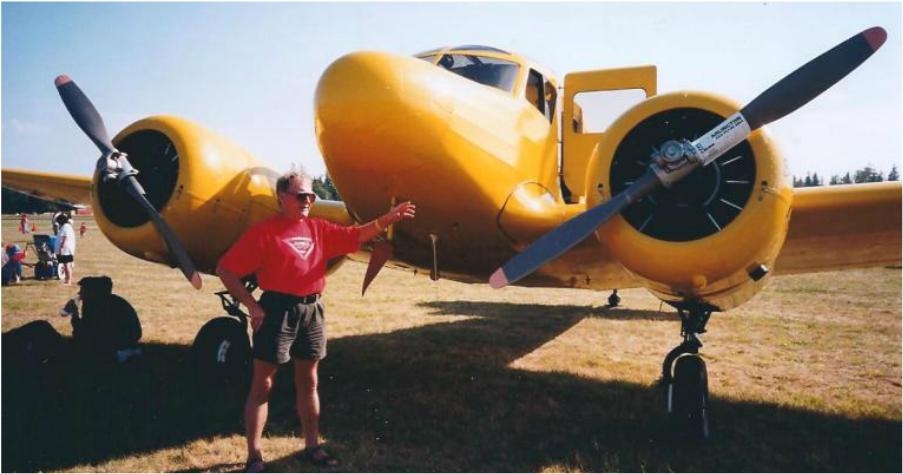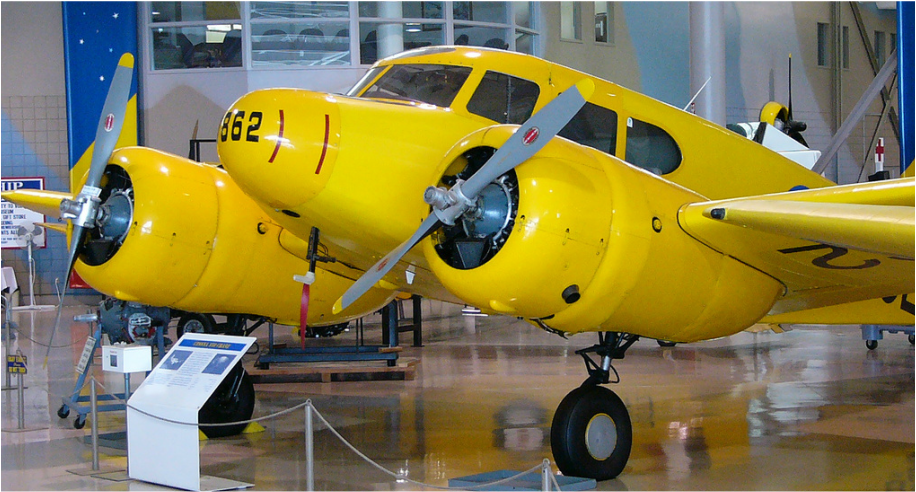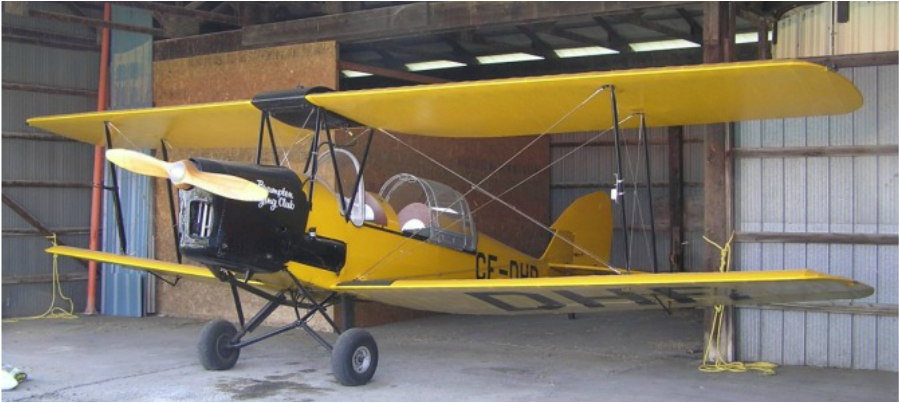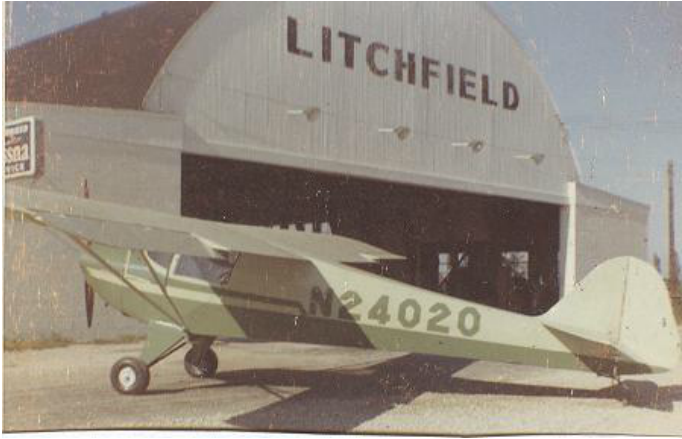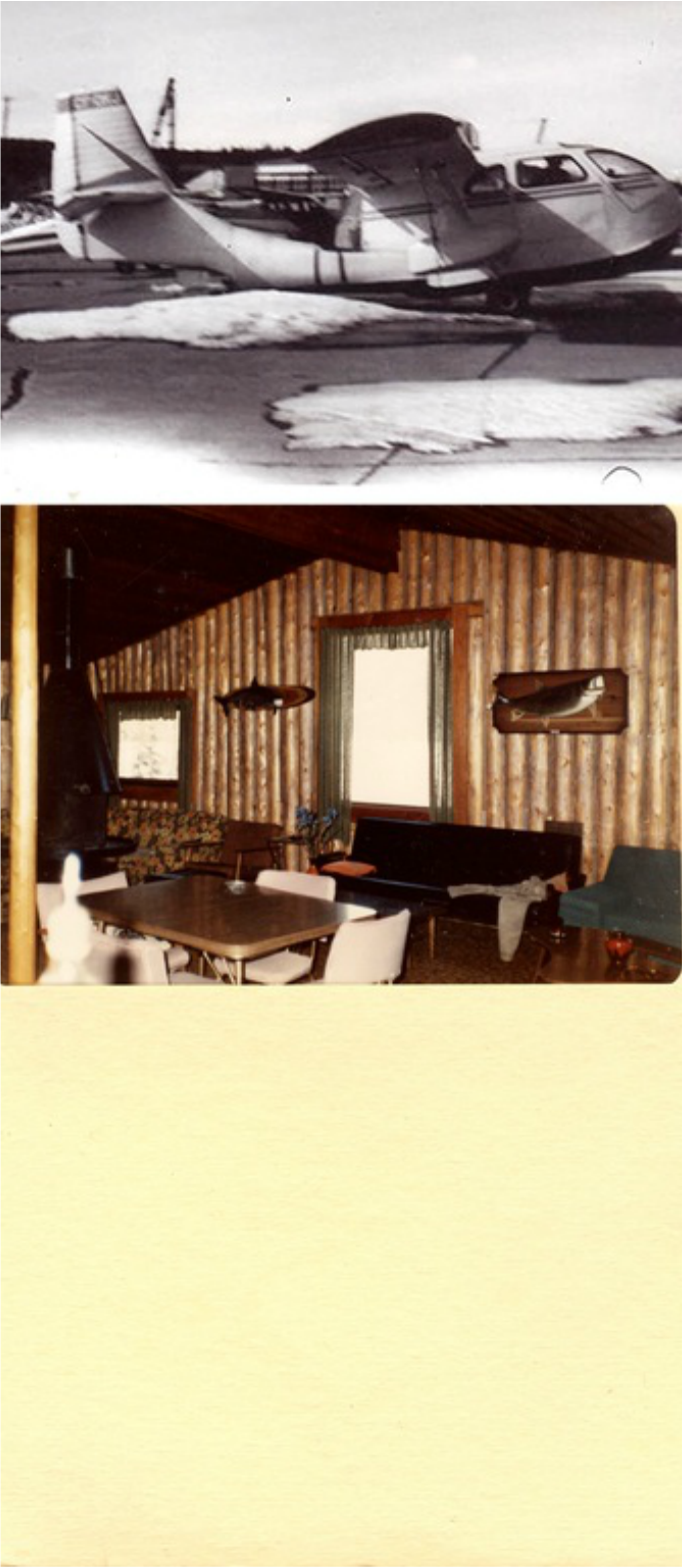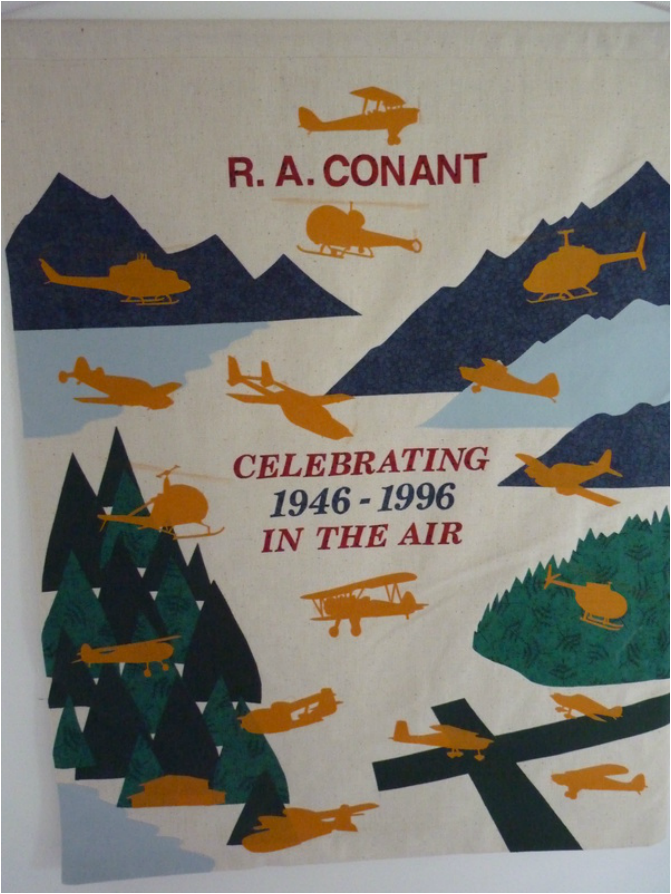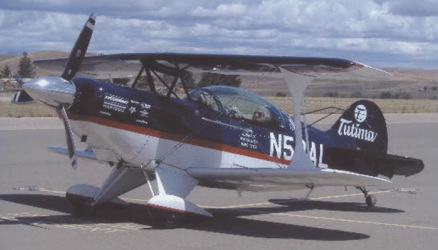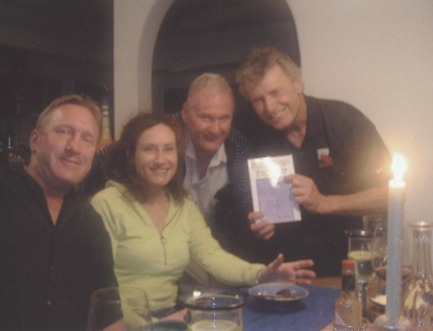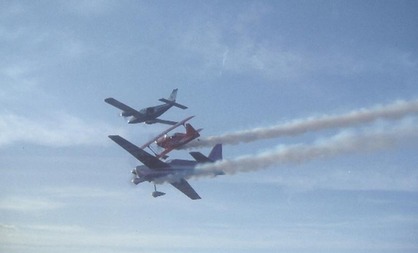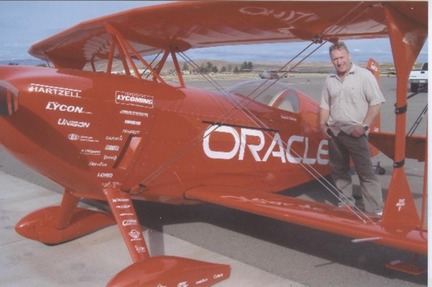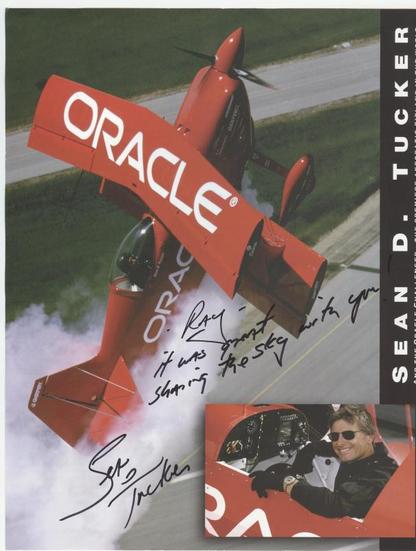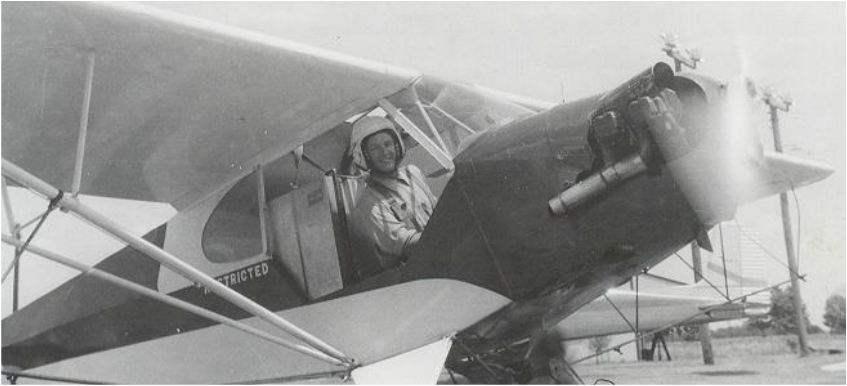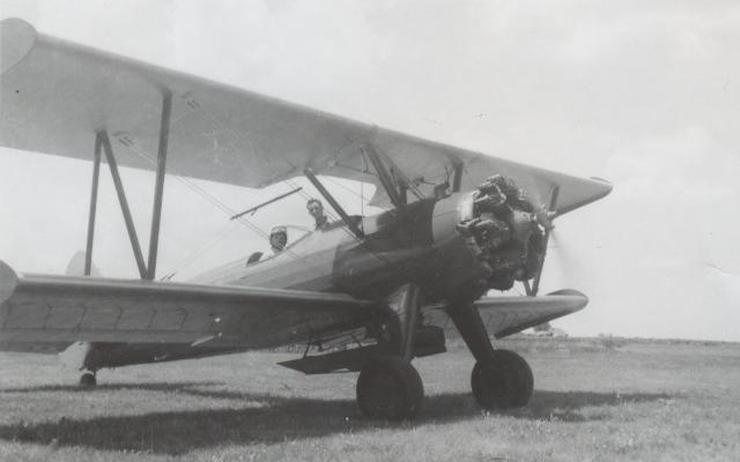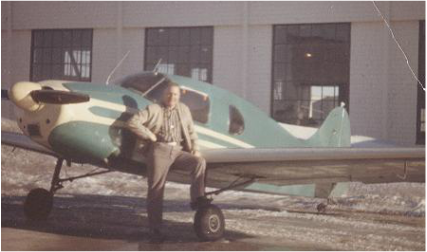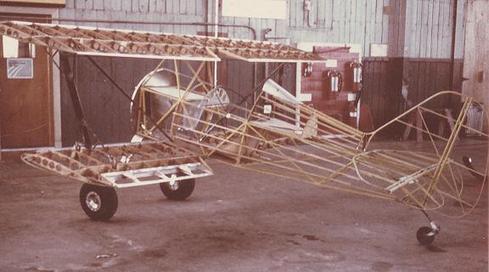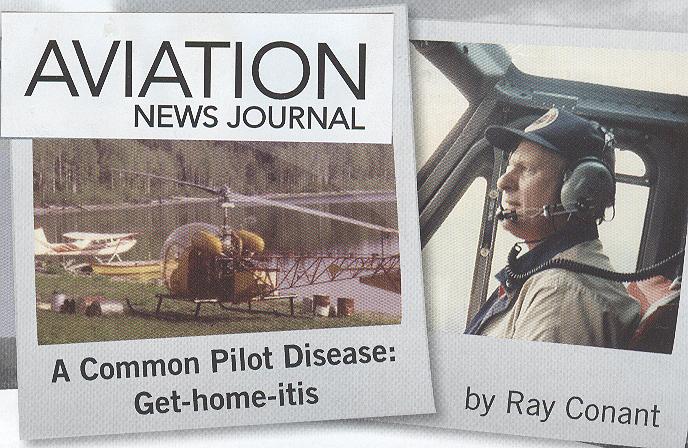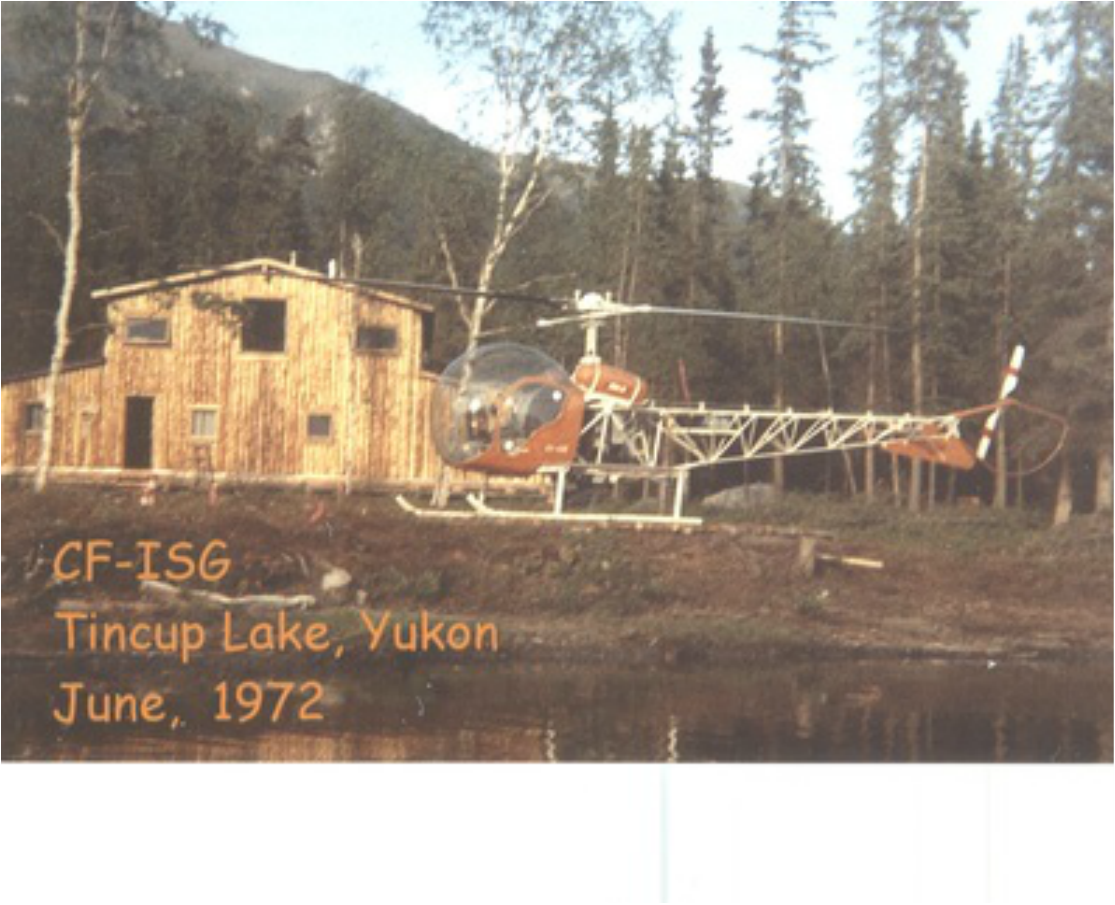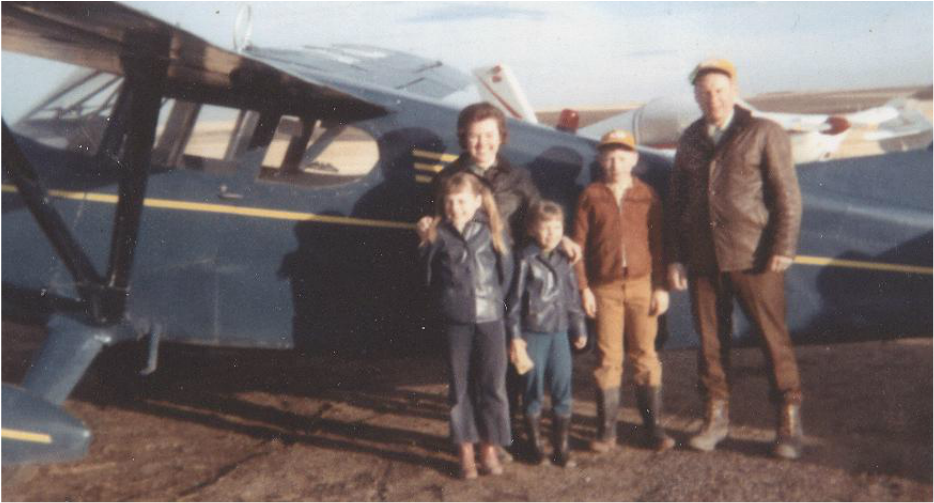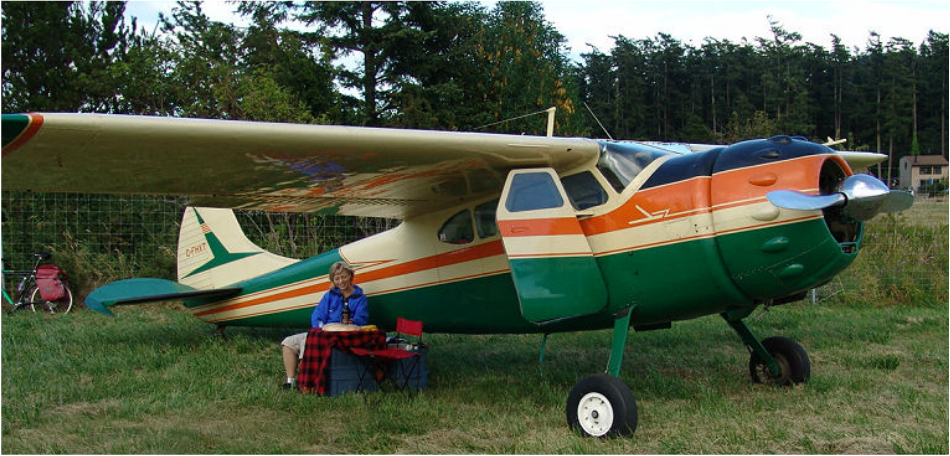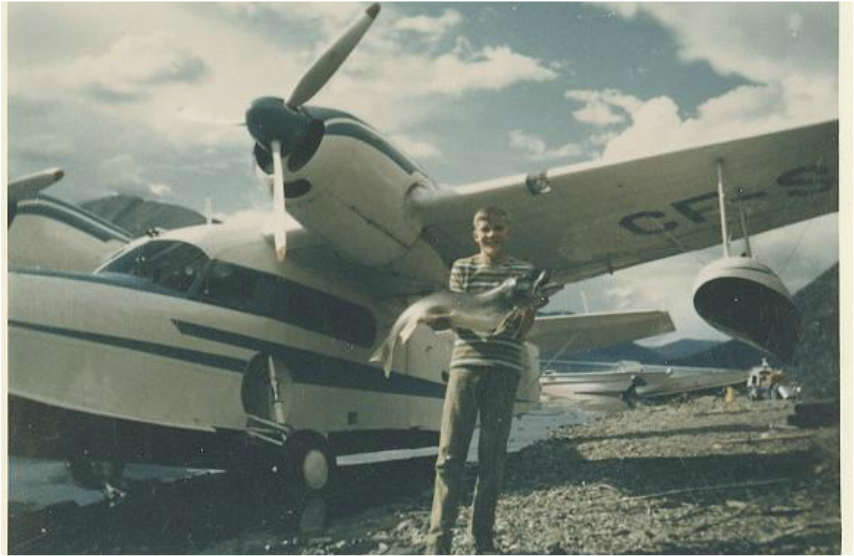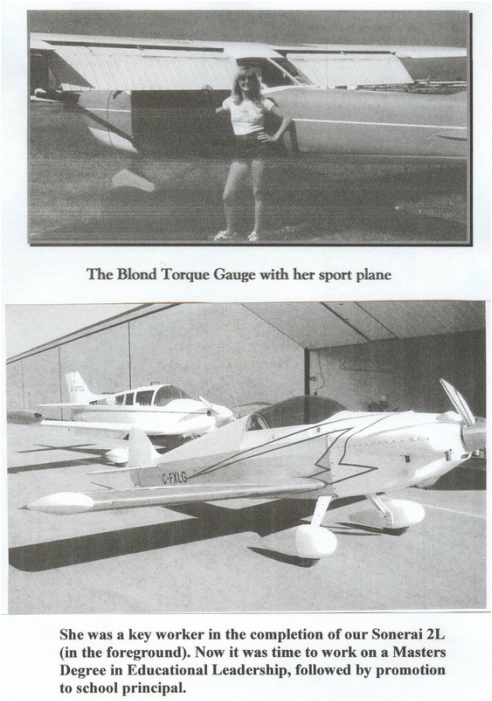WEBSITE 2
|
THE EARLY DAYS OF FLYING WERE VERY DIFFERENT FROM TODAY
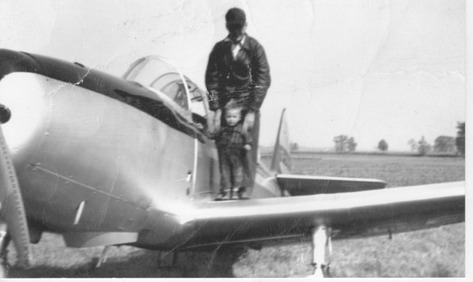
No, I'm the big guy - Bobby is the little guy. He's
my older brother's little boy. This is 1952.
The aircraft is a Fairchild Cornell, CF-CVU, military
trainer which had been in service with the Royal
Canadian Air Force in the Commonwealth Air Training
Plan during (1940-1942 about)) of the Second World
War.
In 1952, my friend Gil Gladu and I somehow dug up
$500 to buy it. This airplane type had replaced the
Tiger Moth biplane, Fleet Finch and Fleet Fort primary
flight trainers. Photo back yard at home, Sarnia, Ont.
PREVIOUSLY - (1948-51 had purchased a Cessna T-50 Crane military twin engine trainer, CF-EXB ($325),
followed by a DeHavilland Tiger Moth biplane military trainer, CF-DHR ($425), a 1935 Taylorcraft, CF-BJO ($250)
and then a ($600) half share in an almost new 65hp Piper J-3 Cub, CF-EDY. photos below.
Except for the Crane and Cornell, these aircraft were used to accumulate the 200 hours of pilot experience
required for a Commercial Pilot Licence, which was issued in the summer of 1951 - to this proud teenager. I
immediately began to fly sight-seeing and charter trips from the St. Claire River, with a Republic Seabee (photo
below) for Mr. Carl Crossley, Faraway Airways, Sarnia, Ontario.
FLYING WAS VERY MUCH DIFFERENT BACK THEN - ESPECIALLY WITH THE PRICE OF MILITARY
SURPLUS AIRPLANES - MUSTANGS WERE GOING FOR $500
my older brother's little boy. This is 1952.
The aircraft is a Fairchild Cornell, CF-CVU, military
trainer which had been in service with the Royal
Canadian Air Force in the Commonwealth Air Training
Plan during (1940-1942 about)) of the Second World
War.
In 1952, my friend Gil Gladu and I somehow dug up
$500 to buy it. This airplane type had replaced the
Tiger Moth biplane, Fleet Finch and Fleet Fort primary
flight trainers. Photo back yard at home, Sarnia, Ont.
PREVIOUSLY - (1948-51 had purchased a Cessna T-50 Crane military twin engine trainer, CF-EXB ($325),
followed by a DeHavilland Tiger Moth biplane military trainer, CF-DHR ($425), a 1935 Taylorcraft, CF-BJO ($250)
and then a ($600) half share in an almost new 65hp Piper J-3 Cub, CF-EDY. photos below.
Except for the Crane and Cornell, these aircraft were used to accumulate the 200 hours of pilot experience
required for a Commercial Pilot Licence, which was issued in the summer of 1951 - to this proud teenager. I
immediately began to fly sight-seeing and charter trips from the St. Claire River, with a Republic Seabee (photo
below) for Mr. Carl Crossley, Faraway Airways, Sarnia, Ontario.
FLYING WAS VERY MUCH DIFFERENT BACK THEN - ESPECIALLY WITH THE PRICE OF MILITARY
SURPLUS AIRPLANES - MUSTANGS WERE GOING FOR $500
HERE'S A QUICK CATCH-UP FROM THE VERY BEGINNING
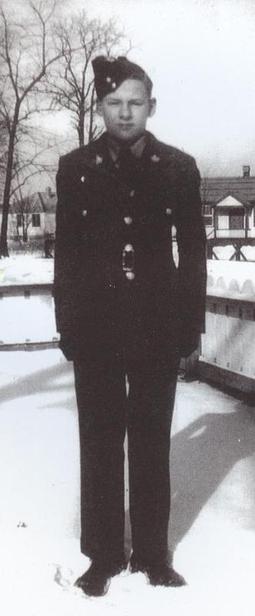
I was born the second son of a chicken farmer in Ottawa, 1931. We were deep
into the great depression and times were tough. By 1938 our family of five had
moved into a log cabin with grandpa and grandma about 150 miles north-east of
Toronto, seven miles into the bush from Whitney.
One day, at seven years old, I noticed something yellow droning along high
above.It was an RCAF (Royal Canadian Air Force) training aircraft of some kind and I
must have been really impressed. The memory and feelings of that very early urge to
fly are still with me. That day I would have been wearing gum boots, braces to
hold my pants up, and binder twine for a belt. I specifically recall leaning against a
huge rock beside a wild gooseberry bush while chewing on a long juicy straw of
fresh Timothy hay. Strange, but that's how I remember it.
War moves on rubber. The Japanese had cut off all supplies of natural
rubber. So, in 1942 we moved to Sarnia, Ontario, where dad became a carpenter
in constructing the synthetic rubber plant that was crucial to winning the war.
Every male in high school was required to join the sea cadets, the air cadets, or the
army cadets. Young men were preparing for war, and my choice of the air cadets
was obvious. Air Cadet Squadron 44 was sponsored by the Sarnia Optomist Club.
(community-minded businessmen)
Time to Fly. While rising through the ranks I was chosen to take flying lessons.
First lesson, April 3, 1946, age 14, was the first time to touch or even see an actual
airplane up close. This familiarization flight happened in a 65hp Aeronca 7AC
Champion, two seat trainer (photo below). The instructor must have considered this
scrawny buck-teethed, pimple-faced, juvenile in military uniform as some kind of
fighter pilot "wannabe". The ground never did appear in any one window more than a few seconds at a time. He
even demonstrated knife-edge crop-dusting turn-around techniques. Even now I recall my broad inner grin on
final approach back at the airport. Right then I resolved that flying would be my life - no matter what. (Yellow and red
Aeronca 7AC photo below)
First Solo Celebration was to sneak off with the Fleet Canuck trainer and do two loops. (From then on very
little flying would happen without looping, spinning, or playing fancy with chandelles). The day following the
loops, I had climbed to 10,000 feet in Aeronca CF-DVD (photo below) and upon leveling off, realized that in seven
minutes I had to be back at the hangar to go for my first lunch with "the boys." A continuous tailspin from 10,000 feet
down to under 1,000 feet was necessary to get back to the hangar in time. Just made it. I loved to fly.
Again, the reader is reminded that flying was VERY much different back then.
Flight training was with Leavens Brothers Air Service Ltd. at London, Ontario. Instructors were George Walker and
Don Ellis. "The boys" consisted of other flight students who had done their first loop - a firm requirement to join
them for lunch at the airport coffee shop. Needless to say, the looping activity was not discussed with the instructors.
However, tailspins were a common maneuver that instructors encouraged students to indulge any time.
YEAH - very different!.
into the great depression and times were tough. By 1938 our family of five had
moved into a log cabin with grandpa and grandma about 150 miles north-east of
Toronto, seven miles into the bush from Whitney.
One day, at seven years old, I noticed something yellow droning along high
above.It was an RCAF (Royal Canadian Air Force) training aircraft of some kind and I
must have been really impressed. The memory and feelings of that very early urge to
fly are still with me. That day I would have been wearing gum boots, braces to
hold my pants up, and binder twine for a belt. I specifically recall leaning against a
huge rock beside a wild gooseberry bush while chewing on a long juicy straw of
fresh Timothy hay. Strange, but that's how I remember it.
War moves on rubber. The Japanese had cut off all supplies of natural
rubber. So, in 1942 we moved to Sarnia, Ontario, where dad became a carpenter
in constructing the synthetic rubber plant that was crucial to winning the war.
Every male in high school was required to join the sea cadets, the air cadets, or the
army cadets. Young men were preparing for war, and my choice of the air cadets
was obvious. Air Cadet Squadron 44 was sponsored by the Sarnia Optomist Club.
(community-minded businessmen)
Time to Fly. While rising through the ranks I was chosen to take flying lessons.
First lesson, April 3, 1946, age 14, was the first time to touch or even see an actual
airplane up close. This familiarization flight happened in a 65hp Aeronca 7AC
Champion, two seat trainer (photo below). The instructor must have considered this
scrawny buck-teethed, pimple-faced, juvenile in military uniform as some kind of
fighter pilot "wannabe". The ground never did appear in any one window more than a few seconds at a time. He
even demonstrated knife-edge crop-dusting turn-around techniques. Even now I recall my broad inner grin on
final approach back at the airport. Right then I resolved that flying would be my life - no matter what. (Yellow and red
Aeronca 7AC photo below)
First Solo Celebration was to sneak off with the Fleet Canuck trainer and do two loops. (From then on very
little flying would happen without looping, spinning, or playing fancy with chandelles). The day following the
loops, I had climbed to 10,000 feet in Aeronca CF-DVD (photo below) and upon leveling off, realized that in seven
minutes I had to be back at the hangar to go for my first lunch with "the boys." A continuous tailspin from 10,000 feet
down to under 1,000 feet was necessary to get back to the hangar in time. Just made it. I loved to fly.
Again, the reader is reminded that flying was VERY much different back then.
Flight training was with Leavens Brothers Air Service Ltd. at London, Ontario. Instructors were George Walker and
Don Ellis. "The boys" consisted of other flight students who had done their first loop - a firm requirement to join
them for lunch at the airport coffee shop. Needless to say, the looping activity was not discussed with the instructors.
However, tailspins were a common maneuver that instructors encouraged students to indulge any time.
YEAH - very different!.
1946 Aeronca 7AC Champion (65hp) Same as CF-DVD (the spin aircraft above). Same paint job too.
___________________________________________________________________
BELOW: Cornell CF-CVU in background, my Dad on left, Gil Gladu center, me right. This aircraft has a 175hp Ranger, 6 cylinder inline inverted engine. They do beautiful rolls. This crumpled and faded photo (Kodak box camera) was taken behind our house in Sarnia, Ontario, 1952. A few of these aircraft are still flying. This particular one doesn't appear to be. A museum back east has one in first class flying condition. The Norwegian Air Force trained on these in Alberta - on skis.
ABOVE: The Cornell as a military trainer with the RCAF Commonwealth Air Training Plan about 1942. These were sold off post-war cheap (in flying condition) to anyone with a few hundred bucks, just as also the Cessna T-50 Crane twin trainer below, plus Fleet Finches, Fleet Forts, Yales, Harvards, Ansons, and even Mustangs. A friend had an Avro Lancaster four engined bomber in his back yard still in 1960. I used it's throttle linkage rods for wing drag bracing on my homebuilt Mong sport biplane - the frame of which is pictured in the slide show above.
___________________________________________________________
ABOVE: CESSNA CRANE: Top Photo is a Canadian-owned Cessna T-50 Crane at an air show in Arlington WA about 1990. Mine was hangared at London, Ontario, had fixed pitch wooden propellers, new Jacobs L4M-B 245hp engines, and had been repainted bright red. It sported a Lear Orienter radio. I traded it off in 1950 for Tiger Moth biplane CF-DHR. Bottom Crane Photo: A museum display. Some are still flying in the USA. (For Cessna Crane flying Google Sky King Dust of Destruction).
___________________________________________________________
ABOVE: A great big thank you goes out to George Trussell for providing this recent photo of the actual Tiger Moth DH82C, CF-DHR, dear to this teenager, in 1949. It's still around!!! Now it's owned by the Brampton Flying Club (Toronto area). DHR was their very first aircraft back in 1946. (Check their excellent website). In the late 1960's DHR
was rebuilt after damage. Tiger Moths use a 140hp Gypsy Major inverted inline, four cylinder engine. It was my privilege to tow gliders and sailplanes with the club Tiger Moth at the Gatineau Gliding Club in Ottawa while there in summer, 1951. Got glider trained too.
_______________________________________________________________________________
with a single ignition, 38hp engine, no wheel brakes, and a tail skid instead of a tail wheel. She provided 47 hours of harum-scarum flying hours toward the commercial licence. We imported the above gift aircraft into Canada - Alberta, as CF-MOU in 1961.
|
LEFT: Remember CF-BJO, (Banjo) the 38hp Taylorcraft mentioned in the opening paragraph above - well it looked like this 65hp model which was a college grad gift from my parents-in-law in Litchfied, Illinois, in 1959. Banjo was yellow, and was designed
|
* * * * * * * * * * * * * * * * * * * * * * * * * * * * * * * * * * * * * * * * * *
INSERT: A 2009 AEROBATIC EXPERIENCE.
In the winter of 2008-09 my son Matt flew Sean D. Tucker, a world champion aerobatic pilot, during a week of helicopter skiing at a fly-in ski lodge in the British Columbia mountains. As a result Matt and I were invited for a five day stay at Sean's home near Salinas, CA. (Monteray area)
While hanging around the flight activities at his aerobatic flight school at King City, I came away with 2.5 hours of intense aerobatic flight instruction. I'm determined to go back.
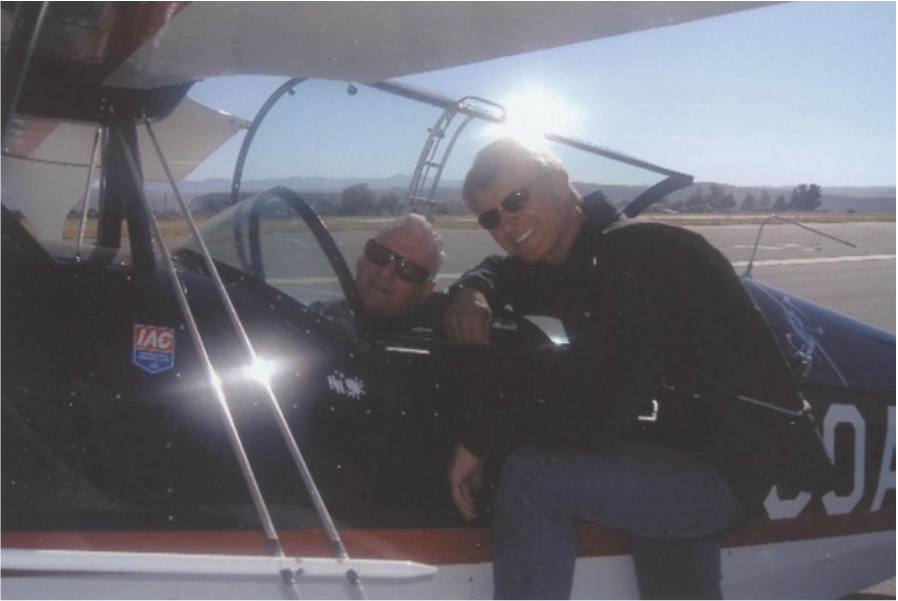
Preflight briefing with Sean. Maneuvers on this flight included inverted flat spins, snap rolls, and two very
low level (20 feet) inverted fly-pasts. This is a Pitts S-2B behind a 260hp Lycoming engine. Play the u-tube
below for some wild aerobatic flying by Sean.
BELOW: Other training included airshow aerobatics on an Extra 300L with Ben Freelove, instructor and
member of the show team. Instruction - snap rolls, inverted flying maneuvers, spins and lomjevics (forward
tumbling). No photos.
Be sure to have your speakers "ON" for the background music. It's great!
Zoom to fill your computer screen.
* * * * * * * * * * * * * * * * * * * * * * * * * * * * * * * * * * * * * * * * * * * * * * * * * * * * * * *
NOW LET'S RESUME HISTORY WITH THE COLLEGE YEARS 1954 - 1960
School was Concordia Theological Seminary, Springfield, Illinois. Student summer employment was at the Litchfield, Illinois airport 40 miles south. Besides spray, charter and instruction flying, aviation gas customers needed service (30 cents/gallon), and the hangar floors always needed sweeping.
ABOVE: This 135hp hot rod modified Piper Cub sprayer also helped pay for tuition and books. We sprayed weed killer, defoliant, dieldrin, and various insecticides (DDT) on corn, soya beans and sorghum fields. Today just about all these chemicals are banned.
RIGHT: Wearing goggles in an open cockpit, and looking forward through a maze of struts and wires takes getting used to - especially flying three feet off the crop. This is a 220hp Lycoming powered, high lift wing, Boeing Stearman.
|
On the wing is Jake Schelt, mechanic. Underneath is a spreader for
granular DDT for the control of corn borer worms. |
___________________________________________________________________
1960 - BACK TO CANADA AFTER GRADUATION - DRUMHELLER, ALTA
LEFT PHOTO - At Drumheller. Chris Ostergard and I bought this fast four seater 1946 Bellanca Crusair, CF-MVY from a Saskatchewan farmer. Farthest journey was a fishing trip to Watson Lake, Yukon. Photo is at Calgary airport.
RIGHT PHOTO - Chris did most of the welding construction on the fuselage of this Mong Sport, CF-SIK. I took it over and built the wings, ailerons, and tail surfaces. A 150hp Lycoming engine was standing by for installation when my family moved to Whitehorse, Yukon. We took the airplane, but didn't complete it - too busy with helicopters. This photo is in a hangar at Whitehorse. Sold - it was completed by a doctor in Edmonton and is still flying - I think.
* * * * * * * * * * * * * * * * * * * * * * * * * * * * * * * * * * * * * * * * * * * * * * * * * * * * * * * *
HELICOPTER YEARS BEGIN IN 1962
....but airplane flying continued mixed in
1962 Winter/Spring Helicopter training in Calgary: Bulloch Wings & Rotors. Summer job on a Bell 47G and G-2 on floats for Spartan Air Service on a Manitoba Forest Service contract - photo on home page.
1963 - 1964. Three of us operated a mineral exploration company. We worked in north central BC using the
Cessna 180 floatplane and Bell 47G-2 helicopter pictured in the AVIATION NEWS JOURNAL article below.
This article is from the July/August 2012 issue. Now available as a Back Issue.
A total of seven articles were written for this magazine.
___________________________________________________________
YUKON AVIATION ACTIVITY 1965 TO 1974
Moved family from Spruce Grove, Alberta, to Watson Lake Yukon in May of 1965. Established helicopter operating base here with a Bell47G-3 for Foothills Aviation Ltd of Calgary. In the Fall of 1965 moved to Whitehorse, Yukon.
Except for two years building and operating a fly-in nature lodge in the early 70's, this was concentrated helicopter time. The 12 true stories in the book are from this period - all but one.
Google: Tincup Wilderness Lodge, it's still operating. Check History and 1969-72. Lots of flying both helicopters and airplanes. Don't miss the photo gallery - this kind of country is a wonderful part of every bush pilot's life experience.
This vertical log lodge, built on permafrost, served well and solid for eleven years - until a fire.
It had seven double occupancy guest bedrooms downstairs and three staff rooms upstairs. One bedroom was for the registered nurse, who also tended bar, kept wood on hand for the fireplace and tidied up. For details about the lodge building and operation see the history section on their current website.
www.tincup-lodge.com The current owner/operator has a Robinson R-44. My Bell G-2 below.
ABOVE: My family: L to R: wife Lynne, Cheryl, Alison, Matt and Stinson 108-2 at Drumheller, Alberta. A visiting trip from Whitehorse, 1970. (As of now, 2017, Matt has over 17,000 hours on helicopters)
__________________________________________________________________________________________
Above: In 1969, in Whitehorse, we had a Cessna 195 CF-EML - no photo. The C-195 above belongs to Rob Spindrift on Vancouver Island. Thanks for the great photo Rob.
__________________________________________________________________________________________
Above: This is my beloved Grumman Super Widgeon, younger sister to the Grumman Goose, at our lodge on Tincup Lake in the western Yukon, 1970 - 1972. Google: www.tincup-lodge.com and click
History 1969-1972 for beginnings, photos, and original promo movie (a restored well-worn 16mm).
___________________________________________________________________
THE HELICOPTER YEARS 1962-2000
To Fly is Human - to Hover is Divine
Spring of 1962
Helicopter training at Bullock Wings and Rotors in Calgary, Alberta. Aircraft on a Bell 47G, CF-KGQ,
equipped with a Franklin engine and hydraulic controls. Instructor Evan Bullock. This 25 hour course was
all the training required in those days to add a helicopter endorsement to a fixed wing airplane
licence. I added five hours for good measure. Would you believe a standard going rate of $75 an hour.
In May of '62 bought a Bell 47G-2, CF-INX, with a partner ($25,000 completely overhauled and heavily
financed), to be leased out for the summer. Before releasing the aircraft I flew 36 hours in five days.
Now, with a total of 61 hours toward the 75 hour minimum experience requirement for insurance coverage,
I was hired by Spartan Air Service in Calgary to fly a summer contract for the Manitoba Forest Service
using a Bell 47-D1 on floats. (photo on HOME page is modified to G-2 fuel tanks). These are the very early
mechanical control models as used in the Korean war of the 1950's, and seen in the TV series M.A.S.H.
_______________________________________________________________________________
From Then To Retirement From Commercial Helicopter Flying In 2000
1) From 1962 to 1974 flying was mostly Yukon, NWT, northern BC, northern Alberta, Manitoba
and some Alaska with several long ferry flights from Texas to the Yukon. Most time on Bell 47's, Bell 206
Jet Rangers, Hughes 500, Alouette III, and Sikorsky S-55T.
2) Operated a helicopter flying school in Pitt Meadows, BC from early to late summer of 1976 using
a Hiller 12E. Trained five commercial pilots and one private pilot.
3) In 1977 it was back to the Yukon for a summer on a Hughes 500C (as on book page 119) out of
Mayo for Mayo Helicopters Ltd. - Norm Schultz owner/manager/engineer. Went back to Pitt Meadows for
freelance instructing. Trained my son Matt in Spring of 1978 on a Bell 47G-2 at Pitt Meadows, BC.
4) April 1978 began employment with Alpine Helicopters Ltd, Kelowna, BC., powerline construction
work for BC Hydro (Book cover and Home Page photos). Subsequently did construction and support flying
with Bell 204B, 204C, 205, 212, 412 and Sikorsky S-58T. Included helicopter skiing and hiking, forest
fires, placing power poles, logging, powerline construction, seismic drill moves, pouring cement, placing ski
towers, moving oil well and diamond drilling equipment. Instructing made up much of the off season flying.
5) Hundreds of hours were spent long-lining cedar shake blocks with a Hiller 12E on Vancouver
Island. Commutes between Pitt Meadows and Tofino utilized my wife's Cessna 150 and the Piper Apache
twin. Weather required instrument flying at times. It was handy to be instrument rated. The Honda Gold
Wing got used as well.
* * * * * * * * * * * * * * * * * * * * * * * * * * * * * * * * * * * * * * * * * * * * * * * * * * *
People Have Asked About the Old and Mostly Nostalgic Aircraft Owned or
Co-owned and Operated Privately Over the Years - in approximate order.
(1) Cessna Crane twin engine military surplus (2) Tiger Moth military surplus (3) 1935 Taylorcraft
38hp (4) Fairchild Cornell-military surplus (5) Piper J-3 Cub-65hp (6) 1938 Taylorcraft BL-65
7) Bellanca Cruisair 150hp (8) Bell 47G-2 helicopter (9) Cessna 180 on floats (10) Cessna 195
(11) Stinson 108-2 (12) Super Widgeon-twin amphibian (13) Republic RC3 Seabee (14) J-3 Piper
(15) another Bell 47G-2 helicopter (16) Hiller 12E helicopter (17) Cessna 150 (wife's airplane)
(18) Piper Geronimo Apache 160 twin (19) Cessna Hawk XP (instrument rating on this one)
(20) Cessna 337 twin (21) Sonerai 2L homebuilt (photo below) (22) Cavalier-102 homebuilt -(a
four time Oshkosh Blue Ribbon workmanship winner (photo below).
* * * * * * * * * * * * * * * * * * * * * * * * * * * * * * * * * * * * * * * * * * * * * * * * * * * * * * * * * *
In 2000 Retired From Active Commercial Flying
Occasionally get to fly a Bell 47G-4 helicopter. Put 40 hours on the Cavalier airplane before selling.
There's the Sonerai airplane to fly - sold in April 2012. Last log book entry is January 2010.
Now the dream is to construct a kit-build Mosquito Air single seat helicopter for fun and photography
Check Internet for information on this unique and popular design.
Problem is - - - I'm rapidly fossilizing.
Spring of 1962
Helicopter training at Bullock Wings and Rotors in Calgary, Alberta. Aircraft on a Bell 47G, CF-KGQ,
equipped with a Franklin engine and hydraulic controls. Instructor Evan Bullock. This 25 hour course was
all the training required in those days to add a helicopter endorsement to a fixed wing airplane
licence. I added five hours for good measure. Would you believe a standard going rate of $75 an hour.
In May of '62 bought a Bell 47G-2, CF-INX, with a partner ($25,000 completely overhauled and heavily
financed), to be leased out for the summer. Before releasing the aircraft I flew 36 hours in five days.
Now, with a total of 61 hours toward the 75 hour minimum experience requirement for insurance coverage,
I was hired by Spartan Air Service in Calgary to fly a summer contract for the Manitoba Forest Service
using a Bell 47-D1 on floats. (photo on HOME page is modified to G-2 fuel tanks). These are the very early
mechanical control models as used in the Korean war of the 1950's, and seen in the TV series M.A.S.H.
_______________________________________________________________________________
From Then To Retirement From Commercial Helicopter Flying In 2000
1) From 1962 to 1974 flying was mostly Yukon, NWT, northern BC, northern Alberta, Manitoba
and some Alaska with several long ferry flights from Texas to the Yukon. Most time on Bell 47's, Bell 206
Jet Rangers, Hughes 500, Alouette III, and Sikorsky S-55T.
2) Operated a helicopter flying school in Pitt Meadows, BC from early to late summer of 1976 using
a Hiller 12E. Trained five commercial pilots and one private pilot.
3) In 1977 it was back to the Yukon for a summer on a Hughes 500C (as on book page 119) out of
Mayo for Mayo Helicopters Ltd. - Norm Schultz owner/manager/engineer. Went back to Pitt Meadows for
freelance instructing. Trained my son Matt in Spring of 1978 on a Bell 47G-2 at Pitt Meadows, BC.
4) April 1978 began employment with Alpine Helicopters Ltd, Kelowna, BC., powerline construction
work for BC Hydro (Book cover and Home Page photos). Subsequently did construction and support flying
with Bell 204B, 204C, 205, 212, 412 and Sikorsky S-58T. Included helicopter skiing and hiking, forest
fires, placing power poles, logging, powerline construction, seismic drill moves, pouring cement, placing ski
towers, moving oil well and diamond drilling equipment. Instructing made up much of the off season flying.
5) Hundreds of hours were spent long-lining cedar shake blocks with a Hiller 12E on Vancouver
Island. Commutes between Pitt Meadows and Tofino utilized my wife's Cessna 150 and the Piper Apache
twin. Weather required instrument flying at times. It was handy to be instrument rated. The Honda Gold
Wing got used as well.
* * * * * * * * * * * * * * * * * * * * * * * * * * * * * * * * * * * * * * * * * * * * * * * * * * *
People Have Asked About the Old and Mostly Nostalgic Aircraft Owned or
Co-owned and Operated Privately Over the Years - in approximate order.
(1) Cessna Crane twin engine military surplus (2) Tiger Moth military surplus (3) 1935 Taylorcraft
38hp (4) Fairchild Cornell-military surplus (5) Piper J-3 Cub-65hp (6) 1938 Taylorcraft BL-65
7) Bellanca Cruisair 150hp (8) Bell 47G-2 helicopter (9) Cessna 180 on floats (10) Cessna 195
(11) Stinson 108-2 (12) Super Widgeon-twin amphibian (13) Republic RC3 Seabee (14) J-3 Piper
(15) another Bell 47G-2 helicopter (16) Hiller 12E helicopter (17) Cessna 150 (wife's airplane)
(18) Piper Geronimo Apache 160 twin (19) Cessna Hawk XP (instrument rating on this one)
(20) Cessna 337 twin (21) Sonerai 2L homebuilt (photo below) (22) Cavalier-102 homebuilt -(a
four time Oshkosh Blue Ribbon workmanship winner (photo below).
* * * * * * * * * * * * * * * * * * * * * * * * * * * * * * * * * * * * * * * * * * * * * * * * * * * * * * * * * *
In 2000 Retired From Active Commercial Flying
Occasionally get to fly a Bell 47G-4 helicopter. Put 40 hours on the Cavalier airplane before selling.
There's the Sonerai airplane to fly - sold in April 2012. Last log book entry is January 2010.
Now the dream is to construct a kit-build Mosquito Air single seat helicopter for fun and photography
Check Internet for information on this unique and popular design.
Problem is - - - I'm rapidly fossilizing.
